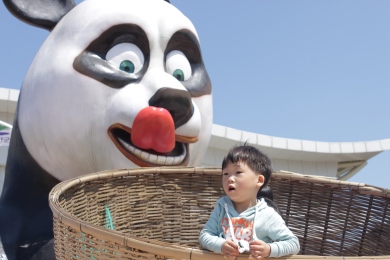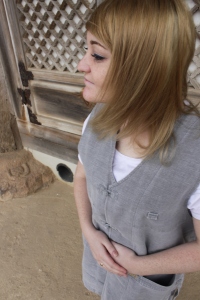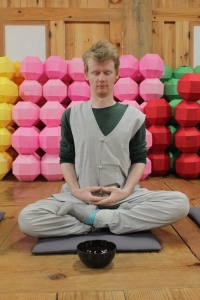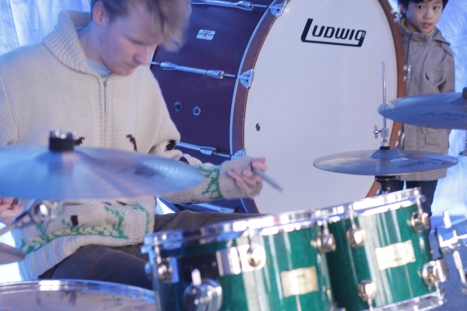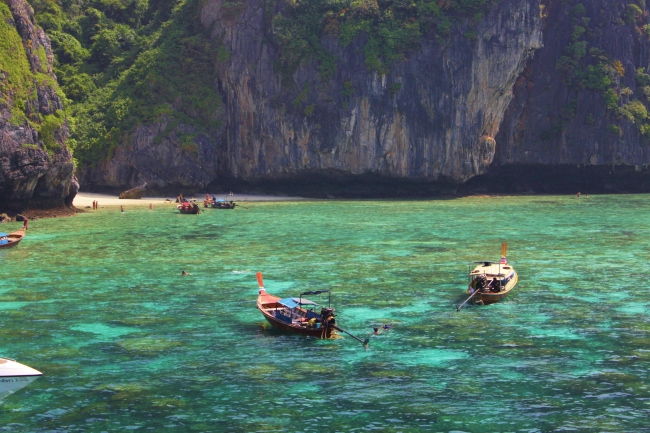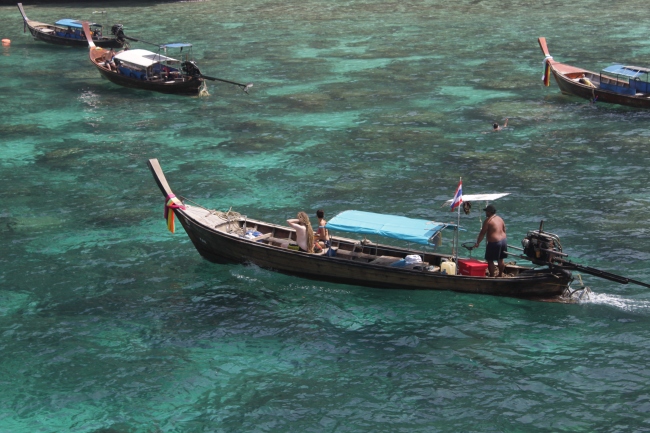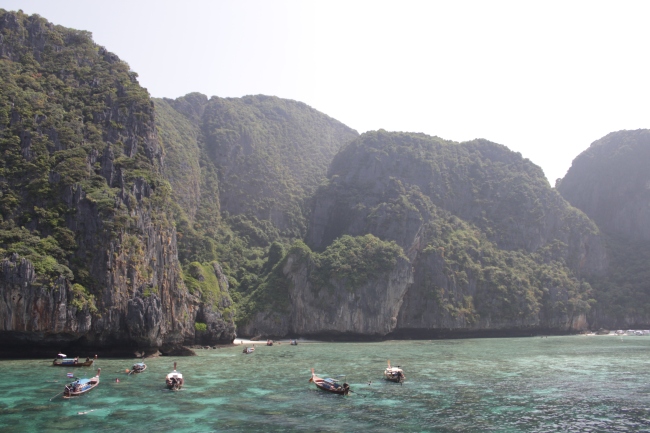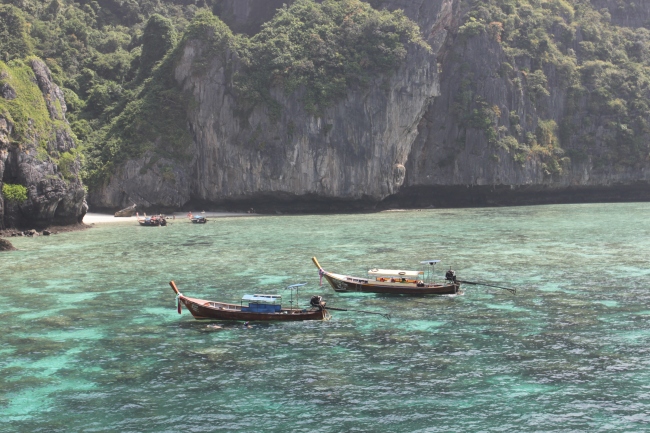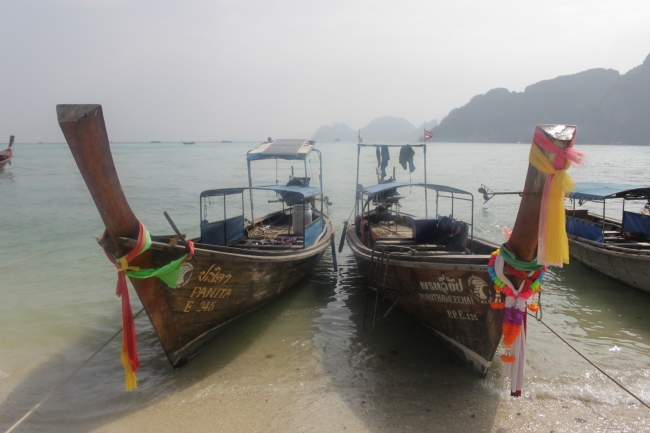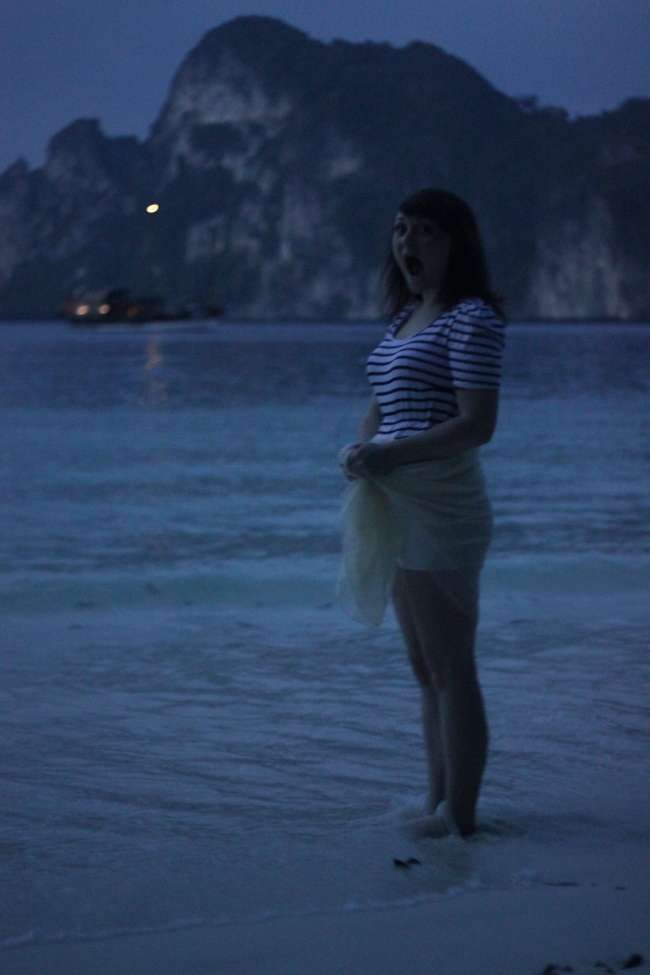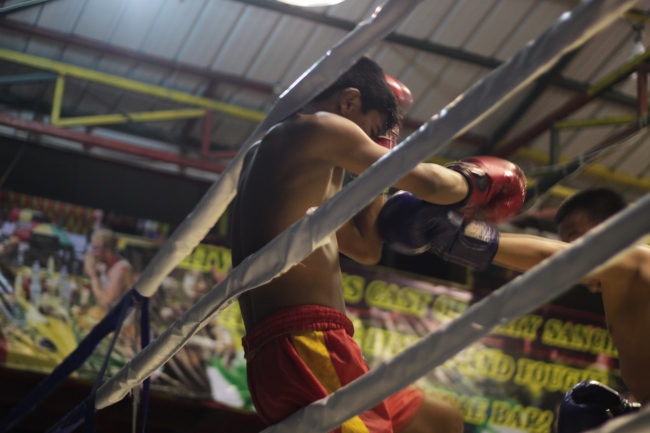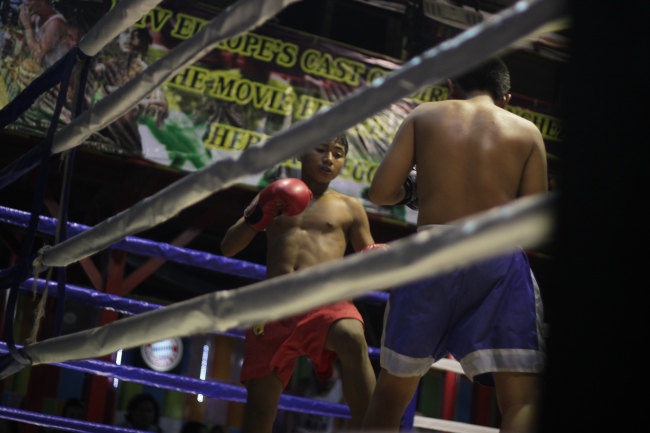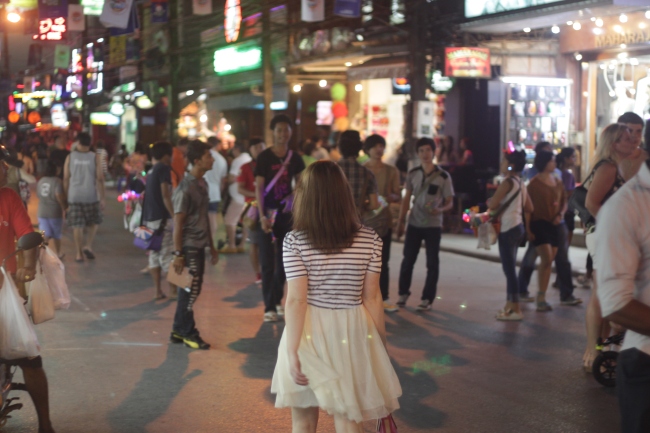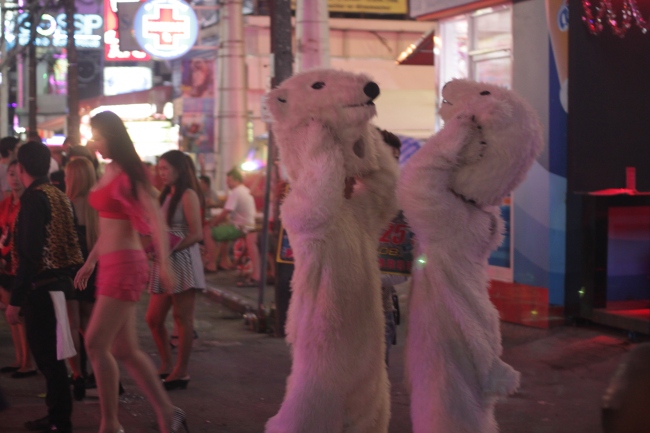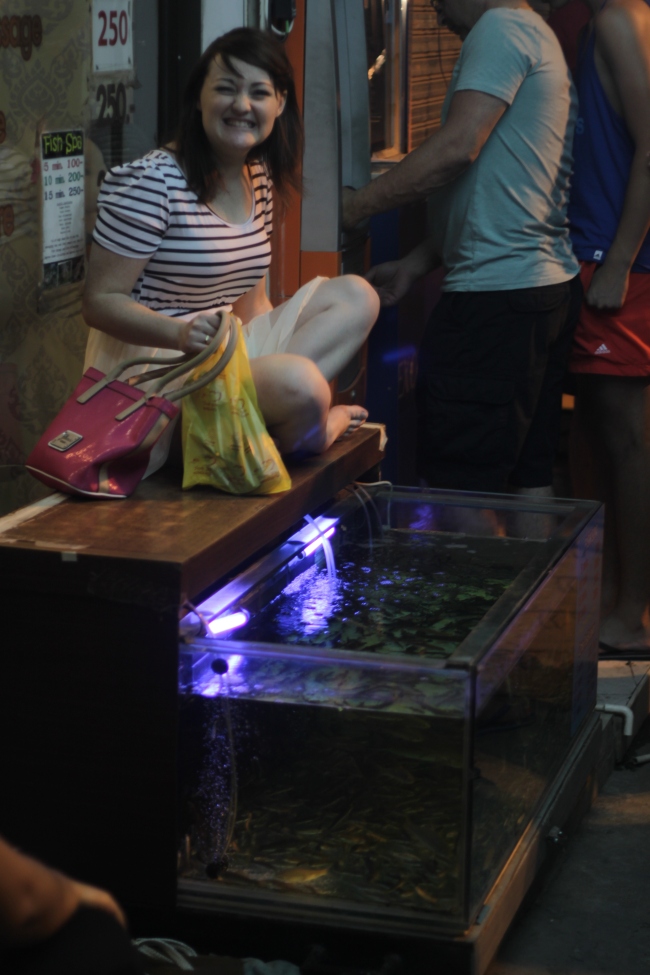Temple 미황사, Nagan Folk Village, and Jeolla Province
Finally, we can say we have visited each corner of this little country! The beaches in the West, the mountains in the East, the city in the North, and finally, Jeollal Namdo in the South.
This province is said to be the “least developed” in Korea, and offers some unique and beautiful things.
We checked out the Damyang Bamboo forest, and rode around the park in this beauty:
and saw this hungry panda!
We also did the breath-taking Wolchulsan Cloud Bridge hike.

The highlight of the trip was definitely the Temple Stay at Mihwangsa (미황사). There was a pretty strict schedule we had to adhere to while visiting.
We traded in our clothes for ones that would allow us to let go of suffering more easily:
The quad was decorated with beautiful colourful lanterns for Buddha’s birthday. Also, all of the food was vegan! But did you SEE that schedule? We had to wake up at FOUR in the MORNING for meditation and prostrations! And we put 108 beads on a string!
We finished up our tour of the south at the quaint little Naganeupseong Folk Village. A little ajumma walked us to a small straw roofed cottage where we stayed for the night. At one time, it was used as a fortress to repel Japanese pirate raids from the South.

Korean Vegetarian Eats!
James and I struggled somewhat when we first arrived in Korea to find food to eat. The first week we were here, we went to a cafe and pointed to a picture on the menu of a bagel five days in a row. Now that we can stumble through some phrases (“ko-gee pbay -go joo-say-yo!”) we have varied our tastes to more that just carbs.
Here are some of our favourite vegetarian eats in Korea.
1) Bibimbap

Every vegetarian’s go to Korean meal. It’s delicious, full of veggies on a bed of rice, cheap, and everywhere in Korea. You can ask for it without eggs if you are vegan. Similarly, the Mom and Pop places that sell bibimbap also usually sell Kimbap (like Korean sushi) that you can get without ham.
2) Jajangmyeon

Ohmygod this stuff is jajangYUM. This is usually only found in Korean Chinese restaurants, which are plentiful around Seoul. It’s noodles drenched in thick, caramelly, black bean sauce, which is salty and filling and oh so good. You have to specifically ask for it without beef (and sometimes shrimp) though, but then they load it up with extra onions, carrots and OH GOD I JUST LOVE IT.
3) Pizza Ddeokbokki

Typically, ddeokbokki is made with spicy meaty sauce, so James and I cook it at home we change the recipe to something we can actually eat. Pizza ddeokbokki is our Korean food that reminds us vaguely like home… It is super filling, super cheesy, and super easy to make. Thick, squishy rice noodles called ddeokk (duck), tomato sauce and cheese. Yum!
4) Cheese Ramyum Dakgalbi

This stuff is spicy hot and salty but it’s good when drinking a few Cass with friends. The guy makes it right in front of you at your table… it’s ddeok again, with ramyum, veggies and a river of cheese. You have to specifically ask for no chicken though… and you will get a weird look.
Going Blonde in Korea
Recently, I auditioned for an English production of Alice in Wonderland in Seoul. After the director informed me I would be playing Alice, (yay!!!) she also told me that she doesn’t believe in wigs.
I have naturally light brown hair, which I dye frequently at home. The director said that she would be paying for the blonde, so I should visit a Korean salon. It took 4 hours, 3 bleaches, and $200.
This is the colour I had last week:
And this is where I ended up:
As you can see, it’s a bit yellow. I asked her if they had blonde toner at the salon. Nope. Koreans don’t use toner because no one has blonde hair. My hair dresser assured me that I would be unable to find toner here. Oh dear.
BUT! I checked G-Market, just for fun, just to see. And lo and behold, Wella Color Charm Toner T14 and T18, in stock!!! I bought a 20 Volume Developer from G-Market also. It’s all being delivered and will (hopefully) arrive soon, along with an update.
봄꽃축제 Cherry Blossom Festival
I don’t mean to brag considering I hear Ontario is still frozen, but it’s spring in Seoul!
James and I went to Yeouido for the Spring Flower Festival 여의도 봄꽃축제. It was packed!
Here are some pictures of the warm weather in Korea!
We also found a little music tent! James’s playing attracted a lot of attention….. his fans all applauded when he finished.
What’s up Gangseo-gu?!
When James and I first learned where we’d be living in Seoul, I immediately Googled our gu. After some disappointing search results, I concluded that Gangseo is not the most happening place in Seoul. I had little expectations beyond a 45 minute subway ride to Itaewon. But, after living in the neighbourhood for nearly seven months, this is how I’ve survived:
Vegetarian Food
“Kogi bay go, joo say yo!” (Take the meat out, please!)
Bon Juk – A chain, with one vegetable juk (yummy rice porridge). You can also get cheese on top!
Pizza School – We get pizza school every Friday. $5.
Tomato Kimbap – A pretty standard mom and pops bibimbap and kimbap place. They know us, so they always take the fish and ham out, but they understand “vegetarian please.”
Talker Toast – Little garlic toast sandwiches with cheese and veggies for 2000 won, and the best yogurt smoothies ever. The lady that works here is so sweet.
Dr Robbins Slim and Healthy! – So good but so expensive. It’s no butter/oil/sugar but does not taste like it.
Norebangs
There are MANY. Norebangs as far as the eye can see! We like Bing Bing and Pink, both of which are off of Ujangsan-ro.
Pubs
Gimsatgat 김삿갓주점 – Just the best. Tucked in behind Ok Norebang, Gimsatgat is more of a traditional Korean atmosphere. You can sit on the floor or at a table. This place serves delicious pajeon (kimchi or potato for vegetarians). For drinks, you can get cheap Cass beer, soju, or makgeolli in the bowls. They don’t speak much English but they are welcoming to foreigners!
Luna Bar – Cute, cozy little bar. They have wine specials from 6 to 10pm most days. They also take music requests and you can smoke inside. English level is pretty good!
Baby Guiness – Close to Songjeong Station, on the way to Gimpo. Lots of drinks/beer/shots, yummy food (and vegetarian stuff!).
Wa Bar – Lots on tap and good atmosphere. Can be expensive… I think it is a chain.
Happy Lunar New Year!
Thailand: Koh Phi Phi
Just a few hours away from Phuket is the gorgeous little island of Koh Phi Phi.
Phi Phi (“pee pee”) gets a lot of flack as being too overrun by tourists to enjoy, but I certainly did not feel this way. As a first time traveler, Phi Phi was exactly what I was looking for – beaches, long tail boats, and sun. As my mother says, I needed to warm my bones.
Our tour ferry took us “sightseeing” around Phi Phi Le, which is where film The Beach was filmed. No one lives on this smaller island (yet) and is just for tourist day trips. We saw the Viking Cave and Loh Samai, and then hopped off the boat at Maya Beach and into the water for snorkelling. Despite the site’s popularity, the water was clear and blue. We could see straight to the coral on the bottom and all of the rainbow fish that lived there.
We hopped back the the big island after snorkelling, which is where all the hotels and restaurants are. Again, with no accommodations planned, we wandered aimlessly, and finally settled on a dorm hostel with bunkbeds. We dropped off our bag and started exploring!

We treked all over the south side of the island for about 3 hours, and sought refuge and popsicles in a sweet little tree house called Carpe Diem. I think it was owned by a hotel, but I prefer the idea that it was created under less capitalistic intentions.
They have pomegranate popsicles!!! So delicious.



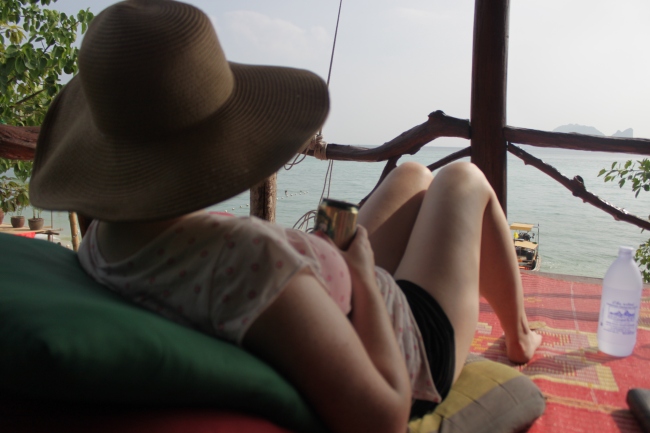


We continued exploring until the beach ended on the south side and we got lost in a big garbage pile.
At twilight, we rented a kayak on and paddled to Monkey Beach on the west side of the island. We were the only people there, and it was dark and I was afraid of monkeys bursting out of the darkness to infect us with rabies.
We searched for twinkling plankton in the water and then headed back for nighttime beach activities. Fire spinning was very popular.
We finished the evening watching some Thai kickboxing at The Reggae Restaurant right beside our hostel. Anyone could go up and fight, and lots of tourists did – a few women who disappointed the crowd, some big frat looking dudes – and two pretty legit looking Thai men.
Tourists wore protective gear: Thais did not.
This place also mini buckets of booze for $4.
The next afternoon we took the ferry back to Phuket and sought recovery. Next stop, Bangkok!
Thailand: Christmas in Phuket
When you can’t go home for the holidays to visit with your family, there is only one thing to do; go to Thailand! The next posts will detail our first real travel experience, including monkeys, a five headed dragon, ladyboys, an oil-y Buddha, and suits.
It’s pretty surreal to walk down the beach and while listening to the baritone vibrato of Bing Crosby’s White Christmas. But on Boxing Day, that’s just what we did. We flew from DMK to Phuket and landed at Patong Beach before noon. We had decided not to book a hotel ahead of time while staying in Phuket, so when the bus dropped us off at the bottom of Bangla Road we wandered around for about an hour (poor James lugging our bag the whole time). We had imagined that we would stay in a beach hut while in Patong, but we could not find anything of the sort, so we settled on a cheap-ish hotel right by the beach.
Here’s James applying some SPF 70.
We walked up and down the beach and finally settled on infamous Bangla Road. During the day it was mostly full of salesmen offering knockoff handbags – when we came back after 7, it seemed to live up its reputation as the party capital of Phuket.
Lots of go-go bars, prostitutes, and drunk foreigners. It was trashy but fun. If you are into celebrity gossip, this is where Rihanna took a photo with an endangered slow loris and got the poachers arrested. We saw no slow lorises on Bangla Road.
After all that excitement, we had a relaxing pedicure from some hungry fish.
The masseuses were laughing at James. They gave him an extra five minutes free!
Afterward, we retired to our hotel and prepared to take off again in the morning for my favourite part of the trip – Koh Phi Phi.
아기 사랑 방, or The moment when after five months of living in Korea I read and understood three words of a subway ad and felt really good about myself
As I’ve read in countless patriotic essays written by the Korean children we teach, Hangul (The Korean alphabet) is a very scientific and practical language. It was all made up by one Korean guy who decided that he didn’t like the Chinese alphabet that Koreans used at the time, because it was a complicated, syllabic alphabet (one letter represents a syllable) that worked for Chinese but wasn’t ideal for Korean. He sat down and made Hangul all by himself, a phonetic alphabet like the Roman alphabet that English uses, where letters represent sounds. This language spread and was adopted by all Koreans because it was easy to learn, simple to use, and also probably because the Koreans didn’t really like the Chinese to begin with.
Hangul really is a simple language to learn- I went from zero to slow but steady literacy in about a half hour. There’s no silent letters, there’s no words like “tough” and “though” and “through,” there are some rules to make note of but once you figure them out you can pronounce words pretty well just by reading them. It would be like if English speakers wrote everything with those phonetic letters you find in the dictionary (‘līk thəs).
Anyway, I’ve been practicing my Hangul by reading every Korean sign, chip package, or bus ad that appears in front of me, and I’ve been getting faster but I have no comprehension. Occasionally I’ll read an English word written in Hangul and that feels good, like I’ve run into an old friend who was in disguise.
But yesterday I saw these three words on a subway in a commercial for a place in the subway stations where mothers can bring their young children to take care of:
아기 사랑 방
I knew what each word meant. I will explain how in a matter much like Slumdog Millionaire but more mundane:
아기: “Agi”
When Sarah first got here, she was teaching a class of four-year-olds and they immediately came up with a nickname for her: “동아기 teacher,” which sounds like “Dongakey teacher.” Sarah thought they were calling her a donkey teacher, which was pretty cute, so she let them call her that.
A few months later, one of the Korean teachers informed her that what they were saying was “Dong Agi” which directly translates to “a poop’s baby,” a particularly vulgar Korean slur.
And that is how I learned that “Agi” means “Baby.”
사랑: “Sarang”
Sarang means “love.” I’m not actually sure how I learned this word. Koreans write this on everything- backpacks, pencil cases, birthday cards, T-Shirts, phone stores- love is everywhere.
방: “Bang”
The most popular leisure activity in Seoul, aside from drinking, is drinking in a Karaoke bar. You are never more than a few doors down from one of these, even when you are already inside one. They’re pretty fun, despite overpriced drinks and a mediocre and cheesy selection of English songs (Sweet Caroline again? All right, hand me the echoey microphone)
Because these bars are everywhere, they were one of the first things I learned to say in Korean. They’re called “노래방,” or “Noraebangs,” which means “Singing room.”
There are also DVD bangs, where you can go and watch DVDs, Jinjibangs, which are sauna rooms, and video game bangs, where you can play Starcraft against people who are legitimate professionals.
It doesn’t take a genius to figure out that “방” means “room.”
So, there you have it. “Baby love room.” A room where you can take your baby, who you love. Three words in another language that I read on my own after being immersed in the culture for a mere five months. Not bad for a guy who took French classes from kindergarten to grade 9 and can’t even order a grilled cheese at La Belle Province in Montreal successfully.


